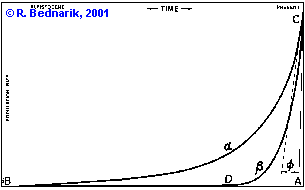NEW
Taphonomy deals with the logic underpinning the idea that the quantified characteristics of a record of past events or systems are not an accurate reflection of what would have been the record of the living system or observed event.I am, using as part of taphonomy, the ideas behind the life time of objects/records as describe by the Weibull distribution. In general; taphonomy provides insight in the process that older objects tent to survive less than younger ones and that older ones are changed more than younger ones.
a curve is the produced objects and b curve is the surviving objects
point D is taphonomic threshold (as defined by Bednarik)


| Rock type | Weathering
[mm/1000 years] |
| Sandstone* | 5-50 |
| Limestone* | 2-20 |
| Schist | 1-10 |
| Marble | 0.4-5 |
| Dolomite | 0.3-2,5 |
| Serpentine | 0.25-2.5 |
| Diabase, porphyry, greywake* | 0.2-2 |
| Gabbro | 0.1-1.5 |
| Diorite | 0.1-1 |
| Quartzite | 0.1-0.5 |
| Granite | 0.05-0.2 |